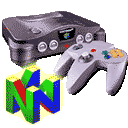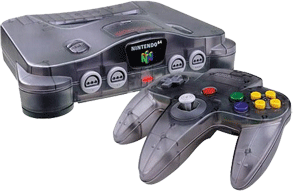Présentation :
The Nintendo 64, also known as Project Reality code and Ultra 64 during its development phase, is a home video game console, released in 1996 (1997 in Europe), the Japanese manufacturer Nintendo in collaboration with Silicon Graphics . It was the last of the fifth generation consoles to be released, competing with the Saturn and PlayStation.


Historique :
The epic of the Nintendo 64 starts on August 23, 1993 with the announcement of "Project Reality": a collaboration of the renowned Silicon Graphics Industry with Nintendo to build the next home console of the firm. Jumping a "generation" Big.N wants to directly produce a 64 bit. Howard Lincoln, then vice president of Nintendo of America declares with great pomp that this "collaboration with SGI will allow to skip a step by creating a product of the next generation". The tone is given and the war against the 32-bit Sega and Sony declared. Nintendo adds with the announcement of the marketing price of its future console: 250 dollars, two times less than the advertised price of competing machines. The press ignites immediately and it is not long to see the arrival of the first images supposed to match the future capabilities of the machine.
Nine months later (May 5, 1994) Nintendo announces that the "Project Reality" will retain the cartridge support. The games will be developed on roms with a size of 100 MB of data. A figure for the least restricted to the storage capacity of compact discs used for the Saturn and PlayStation (equipped with a CD-ROM drive these machines can tap into 650 MB of data per disk). For Nintendo, the CD-ROM drive is not only too expensive, but it hampers the game because of load times .. Beyond these noble considerations Nintendo particularly feared piracy. In addition, a project to download the games was envisaged (the return of the terminals Disk Writer?): It was therefore necessary that the soft on a size "reasonable". The first difficulties appear for Nintendo: apart from Acclaim, no publisher wants to continue on cartridge whose storage capacity is considered too limited (how to do better than 32 bits with 100 MB of data?). Moreover, with the margins that Nintendo intends to make on sales of its apps, publishers have everything to be afraid. Big.N finds himself quickly alone against all. A fatal mistake since it will cause Nintendo to lose the Final Fantasy (until then all developed on Nintendo machines).
On January 5, 1995, a few weeks after the Saturn was released in Japan, a press release from the Silicon Graphics Industry states that the components of the N64 (then named "Ultra64") are ready. If they are superior to the capabilities of the Saturn and the Playstation, the data sheet is not stunning either, especially since the 64 is not planned for a year. enough to leave the field free to Sega and Sony. On a positive note, the target of $ 250 should be able to be met. A price hardly possible for competitors. Alas, despite this good news, Nintendo announced May 5, 1995 that the release of the Ultra 64 is postponed for November 95 in Japan and April 96 in Europe and the United States. A news that falls at the worst moment: all eyes will be turned on the machines of Sega and Sony at E3 1995!
Three months later, Nintendo finally bombs the chest and presents the pad of the Ultra 64. With its analog stick it is a sensation. The joystick is designed for better control of 3D environments. It will be one of the keys to the success of the console and its fun game. Moreover, the handle has a space to insert a memory card. Nintendo remains the undisputed king of the paddle.
At the Shoshinkai show (December) a demonstration of Super Mario (designed by Master S.Miyamoto) sends everyone waltz. The slap is heavy, very heavy. The characteristics of the 64 had a little disappointed, but the result on the screen is dreamy. The console is renamed Nintendo 64. Taking advantage of the effect of surprise, Nintendo quietly announced a new delay: the official release passes to April 21, 1996. The weeks go by and new disaster: February 1 Nintendo repels an umpteenth time the output of his console . The date falls on September 30, 96. Nothing is said but the games are not ready: the difficulties to respect the storage size of the roms poses many difficulties to the developers. Finally, the machine is released on June 23, 1996 in Japan. Only three games are available: Super Mario 64; PilotWings 64 and Shogi Chess. Despite the "weakness" of the line-up the console created the event. Queues are proliferating and the N64 is selling 300,000 copies. A smashing success. Once again, Nintendo can say thank you to Mario and Miyamoto. Super Mario 64 is indeed flowing as fast as the number of machines sold. Alas, the few games available will come soon enough to "calm down" sales of the N64. Some players even up to resell their material for lack of news. All in all, after all the mistakes made, and a blatant mask of third-party publishers, the Nintendo 64 will have a very nice career dotted with games of anthology: Mario 64; Ocarina of Time; Wave Race; Golden Eye; 1080; Mario Kart; Majora s Mask; F-Zero and many others (including the pearls of Rare) will make the happy days of the happy owners of the bécanne. Today we can say that the cartridge holder will have cost Nintendo a lot. If it is the joy of the impatient (no loading!) And makes the machine more reliable than the 32 bits, the cartridges will have been responsible for many evils: delay of the machine; loss of third-party publishers; and especially loss of Final Fantasy. Video games would probably not be what they are today if Nintendo had switched to CD-ROM.


Spécifications Techniques :
- Processor: Reallity Engine processor based on RISC MIPS R4300i 64-bit technology (economical version of R4000) clocked at 93.75 MHz (MIPS architecture). The R4300i supports the 32 and 64 bit instruction sets of the R4000, it has only one pipeline (ALU and FPU share it) but its efficiency is close to one instruction per cycle. The R4300i has 8 KB of data cache and 16 KB of instruction cache (8 KB for R4000).
- Memory: 4 MB Rambus DRAM (9-bit bytes, 36 MB in total, the 9th is used for parity checking) clocked at 250 MHz. The memory is unified, so it also serves as video memory and sound buffer for example. The Expansion Pack allows you to add 4 Mio, for a total of 8 Mio (72 Mb with parity), and thus allow, if the game supports it, to play in higher resolution with textures of better quality.
- Bandwidth of the actual / efficient memory bus: 536.4 Mio / s / 476.8 Mio / s.
- Co-processor: RCP, clocked at 62.5 MHz. This is the most important component, all data passes through the RCP (which also serves as a memory controller to the CPU). It integrates 2 microprocessors, the RSP and the RDP. The RSP for sound and graphics (raster operations, geometric transformations and lighting, rasterization of polygons), it also manages the back-facing culling and volume culling. The RDP for rendering the display list created by the RSP. It has a texture unit (theoretical fillrate of 62 MTexel / s), with filtering (trilinear and antialiasing) and z-buffer management.
- Resolutions: 256 × 224, 640 × 480 interlaced.
- Polygons / sec: 150,000.
- Colors: 32-bit RGBA with smoothing system. Video output: 21 bits.
- Sound: 16-bit stereo.
- Cartridges: from 4 Mio to 64 Mio (32 Mib to 512 Mib).







 (Rev B).webp)
.webp)
.webp)